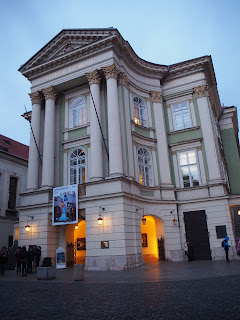Porin Ooppera ry
esittää Suomen juhlavuoden kunniaksi Aulis Sallisen oopperan Ratsumies ja minä
matkustin katsomaan sen ensi-illan. Oopperareissuni osoittautuikin
jännittävämmäksi kuin olin odottanut, sillä junani hyytyi jo Helsingin
rautatieaseman ja Pasilan välillä ja Pasilassa jouduimme vaihtamaan
vararunkoon, jonka kattonopeus oli alempi kuin alkuperäisen junan. Toisin
sanoen, kun lähdimme puoli tuntia aikataulusta jäljessä Pasilasta eteenpäin,
niin seuraavien pysähdysten välillä juna jäi aina vain enemmän aikataulusta.
Kaikeksi onneksi aikataulussa oli pitkä pysähdys Tampereella, jonka ansiosta
saavuimme vain 15 minuuttia myöhässä Poriin. Selvisin siis junarikosta pelkällä
säikähdyksellä.
Ratsumies
kantaesitettiin vuonna 1975 Savonlinnan oopperajuhlilla ja sekin kuuluu
suomalaisiin oopperoihin, joita ei ihan joka vuosi esitetä. Libreton kirjoitti
Paavo Haavikko ja oopperan juoni kertoo suomalaisesta orjapariskunnasta Antista
ja Annasta, jotka surmaavat isäntäparinsa Novgorodissa, joutuvat kiinni
Suomessa, pakenevat vankilasta ja Antti kuolee erään kartanon
valtaamisyrityksessä. Tämän lyhyt juoniversio antaa kylläkin vain aika kalpean
kuvan kaikesta, mitä oopperassa tapahtuu; se on hyvin moninainen kertomus
vahvoista tunteista ja ihmisistä, joita onni nyt ei varsinaisesti potki.
Oopperan
orkesterina toimi Pori Sinfonietta johtajanaan Jan Söderblom. Sallisen vahva
musiikki soikin Porin Promenadikeskuksessa hienosti. Teoksen ohjauksesta
vastasi vuorostaan Erik Söderblom ja ohjauskin oli pääosin oikein onnistunut.
Hieman ihmettelin videoprojisointeja – en ihan aina ymmärtänyt, miten ne
liittyivät tarinaan – ja teoksen aikajana oli aika erikoinen. Toisaalta
Novgorodissa oltiin selvästi 1500-luvulla ja sitten kolmannen näytöksen alussa
yhtäkkiä otettiinkin selfieitä ja räpellettiin tabletteja. Ehkäpä ohjaukseen
yritettiin väkisin sovittaa Suomi 100 –teemaa. Sama skitsofreeninen linja
valitsi muuten Taru Liipolan puvustuksessakin: mukana oli epookkia ja vähän
sitä sun tätä.
Mutta
oopperassahan on aina kuitenkin tärkeintä musiikki ja tämän oopperan miehitys
oli todella onnistunut. Laulajat olivat tasaisen hyviä. Eniten innostuin Anna
Danikista Naisen roolissa. Todella upea ääni. Mutta myös Aki Alamikkotervo
Novgorodilaisena kauppiaana teki poikkeuksellisen onnistuneen roolityön ja
Tapani Plathan Anttina oli erittäin hyvä. Ja, kuten sanoin, hyvin pärjäsivät
muutkin: Mari Palo Annana, Sari Nordqvist Kauppiaan rouvana, Rolf Broman
Tuomarina, Waltteri Torikka Ratsutilallisena ja Hannu Niemelä Matti Puikkasena.
Esityksiä on vielä useampia jäljellä, joten jos teillä on mahdollisuus, niin
suosittelen käyntiä Porissa.




























